The Comprehensive
Consumer Resource for
Safes for the Home and Office
Welcome to Gun Hoo
A safe is a big investment for both those seeking to protect their valuables as well as for gunowners seeking to protect their guns from unauthorized persons and children. I created gun hoo as a resource to help other gun owners, and those seeking to protect their valubles, understand their options, and to help peopole like me find the right safe solution. Our Safe Resources and Buyers Guides section includes all the different kinds of safes, non biaed information them, and places to get em’. There is also a section on Popular Manufacturers: learn about Browning, Chubb, Fort Knox, Stack-On, Honeywell, Liberty, Sentry, Winchester, Cannon, and Molser Safes. Lastly, being a gun owner myself, I included a special section on gun safes which includes some informative article which is intended to serve as a helpful guide to you in making the best possible investment in terms of quality and price. Hope you find the information here helpful! – Chuck
Basic Safe Consumers
- Be realistic about the size and weight of the safe you will need: before buying a safe, it is important to consider the size of the room where it will be placed; make sure the safe will fit through the door frame, this is a simple thing but you will be suprised how many people overlook it! Also, if you’re getting a larger safe, be mindful of the size and the weight of the safe. I’ve heard of people getting hurt trying to get huge safes to the second floor of their home. Some safe owners choose to place larger safes, including gun cabinets, in their garage to make installation easier. If this is the case, it is important to consider securing the gun safe in place, if your garage does not have a strong lock in place. Some gun safe owners choose to bolt their gun safe in place, this is an added security measure taken against theft, but may cause problems in the future if the gun safe needs to be removed for whatever reason.
- For extra security, add a alarm system to your safe: safes with alarms provide an extra layer of security and may deter tampering or theft. Many different manufacturers offer gun safes installed with alarms. Before selecting a gun safe, make sure it is secure enough to meet your needs and expectations. For example, gun safes with thicker metal walls or are those reinforced with heavier materials may be more secure than other lighter models.
- The locking mechanism is one of the most important factors to consider: Most safes are made with electronic locks and mechanical dial locks. The electronic locks may be easier to operate, and are typically very secure. However, it is important to make sure that the batteries in the electric safe are properly maintained and changed as needed. If the batteries in an electric safe are drained, the safe may unlock or lock out the owner. The traditional mechanical dial lock mechanism is also available and may be a good option for gun safe owners who are not comfortable using electric lock mechanisms.
- It is important to buy a gun safe from manufacturers that offer reasonable warranties for their products: It is important that all safe owners review their gun safe warranty and, if needed, follow any maintenance guidelines, so that the warranty is not voided. Keeping any paperwork relating to the safe, including the owners manual is also very important.
Gun Safe Consumers
- Think about why you need the safe and think over the options: If you’re just storing pistols, then a safe designed just for handguns is really all you’ll need – they are much smaller and less expensive by far. If you do need to secure your rifles, shotguns, and ammo, go for a gun cabinets. If you have rifles with scopes mounted, remember that you will need the extra clearance necessary your scopes. It is a best practice to have a gun cabinet in which to store your rifles, scopes, and ammo, a handgun safe for easy access, and a travel safe for your car or truck.
- Make sure the gun safe you are about to buy burglary rated: While a non burglary rated gun safe is good for keeping children out, it will NOT protect your guns from burglars.
- Make sure that the gun safe you are about to buy has a good fire rating: The fire rating of a safe is the number of hours that a safe will survive at 1700 Degrees Fahrenheit before the internal temperature rises above 350 degrees. Just in case of a house fire and for peace of mind, look for a fire rating of at least 30 minutes to a hour.
Gun Safe Types
The type of gun safes to be bought depends on the firearms in possession and the quality of safe needed. Several types of safes are fireproof safes, pistol safes, rifle safes and biometric safes.
Fire safes can withstand the test of fire for extended periods of time before the integrity of the safe is compromised. Remember that not all safes are fire resistent, including many wall and floor safes.
Pistol safes or handgun safes should be considered for owners of smaller handguns. Pistol and handgun safes are typically more compact than gun safe suitable for rifles or larger guns. The pistol safe should be made of high strength material such as steel. The kind of lock used on a pistol safe determines how fast and easy one can retrieve the handgun when necessary.
Some gun safe owners prefer biometric safes. A biometric safe is built with a keypad that recognizes the fingerprint of the owner. Biometric safes should always be properly maintained, so that it can always provide accurate thumbprint recognition. Biometrics safes do not require a combination or code to gain access.
Aside from storing guns, a security safe may be used for a variety of purposed, including storing important documents, such as birth certificates, passports, legal documents and such. Those interested in purchasing a safe to store sensitive materials in should consider a modular safe because they are compact.
Safes can be installed in a number of different forms. The modular safe, wall safe, floor safe, and hidden safe are only a few of the options available to consumers. Each serves a specific function and helps to secure belongings. A gun cabinet may also be a good option for those with more than one or two guns because they typically have the capacity to hold a high quantity. No matter which home safe you choose, it is important that it is secure and meets your needs.
Gun Safe Brands
Today, there are several gun safe brands, including the Sentry safe, Liberty safe, Cannon safe and Fort Knox safe, that are committed to producing quality consumer and commercial grade products. All Liberty safes are properly tested for any potential fault before they are put on the market. Liberty safe has many different models for various consumer and commercial needs; some of these models are the Colonial, Presidential, Franklin and Lincoln. Each of these has security upgrades available for additional protection and peace of mind.
Cannon safes are high quality safes with excellent customer feedback and reviews. Their safes feature fire resistant materials. For instance, they can withstand temperatures above 1,000 degrees Fahrenheit for about 40 minutes or more. Cannon safes typically come with dehumidifiers to resist corrosion and damage. Cannon safe come in a variety of colors.
Sentry Safes have been in the market for over 60 years. The kinds of safes they produce include electronic safes, combination safes and biometric safes. Sentry safes have high quality with reasonable prices to cater to the needs of the consumer market.
Fort Knox Safes have the advantage of being approved by the consumer protection organization known as Underwriters Laboratory (UL). Fort Knox safes are also fire proof and come with a lifetime warranty that covers lock and print. Their rack and pinion gear drive locking mechanism is strong and difficult to damage or break.
It is one thing to just buy a gun safe; it is another to invest in a high quality safe for the protection and preservation of both firearms and sensitive documents. When choosing a safe, it is important to keep in mind the purpose of the safe and the life expectancy of the safe. There are too many companies that disregard the importance of producing quality products that last and meet the expectations and needs of their customers. Consumers need to research and consider all options before investing in a high quality gun safe.
Rifle Safe
The rifle safe is a protective and secure storage space for rifles. Usually a rifle safe provides adequate space for two or more rifles.
Electronic Safe
Looking for a safe to store guns and other valuables? If the answer to the question is yes, then an electronic safe is definitely an option to consider.
Biometric Safe
Purchasing the right gun safe is important for anyone who owns at least one firearm. After all, without a place to store them securely, there is a real danger…
Hidden Gun Safe
The problem with having a gun safe in the house is that it arouses curiosity. Children will know that the safe contains firearms or something valuable…
Hand Gun Safe
A safe is defined as a storage unit that allows you to secure objects such as: currency notes, jewelry…
Fire Proof Safe
Gun safes are appropriately designed stores for keeping rifles and guns…
Gun Cabinet
Its not easy to make a decision to purchase gun cabinets simply because there are many different…
Home Gun Safe
Home security specialists agree that owning a home safe is an essential part…
More>>
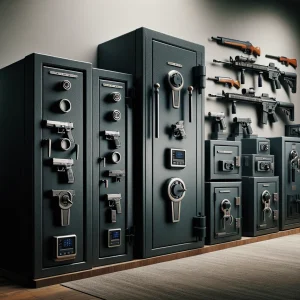
Viking V Series Gun Safes: Secure & Innovative
In the realm of firearm safety and security, the Viking V Series stands out for its robust construction and advanced locking mechanisms. This article delves into the innovative

Hayman MagnaVault: Secure & Stylish Safe Options
When it comes to securing valuables, the Hayman MagnaVault stands out as a robust option for both residential and commercial use. Its advanced security features, customizable options, and

Mesa MBF Safe Review: Secure and Fire-Resistant
Gun safes are an essential part of responsible firearm ownership, providing security not only against theft but also against accidental access. The Mesa MBF series safes stand out
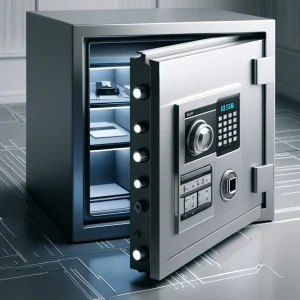
Review: Stealth SwiftVault 2.0 Biometric Safe
The Stealth SwiftVault 2.0 stands out in the market of biometric safes, providing secure and swift access to firearms when needed most. This model caters especially to those

Review: TITAN Mountable Pistol Vault – Secure Storage
In the world of firearm safety, securing your guns in a reliable safe is not just a precaution; it’s a responsibility. The TITAN Mountable Pistol Vault emerges as

Barksa Rifle Safe Review: Secure, Biometric Access
Gun safes are an essential piece of equipment for firearm owners, providing security and peace of mind. The Barska Quick Access Biometric Rifle Safe offers a blend of

Review of LANGGER V Slider Handgun Safe: A Closer Look
When it comes to securing your handguns, the LANGGER V Slider Handgun Safe offers a compelling blend of quick access and reliable security. In this review, we will
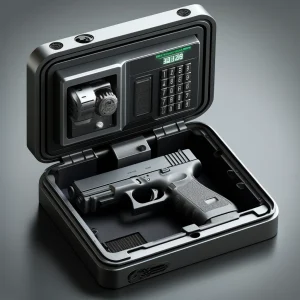
Review: Barska Biometric Handgun Safe
In the world of firearm safety and security, biometric gun safes represent the pinnacle of convenience and rapid access. Among these, the Barska Biometric Handgun Safe stands out

SecureIt Model 47 Review: Compact Gun Safety
The SecureIt Tactical FAST Box Model 47 gun safe stands out in the market for its compact size and versatility. Designed to cater to the needs of firearm
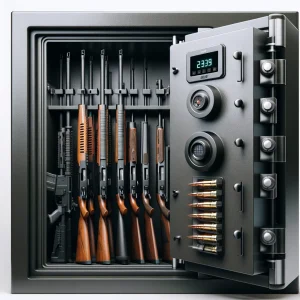
Steelwater GSLD593924-BLK Gun Safe Review
When it comes to securing firearms, the safety of both the gun owners and their families is paramount. The Steelwater GSLD593924-BLK long gun safe stands out as a

Edison Foraker F603024 Gun Safe Review
When it comes to storing rifles securely, the choices can be overwhelming. However, the Edison Foraker Series F603024 stands out as a particularly versatile and robust option. In

The Role of Gun Locking Devices and Safe Storage
Firearm ownership brings with it a crucial responsibility: ensuring that guns are stored safely and securely. Proper storage prevents unauthorized access, reducing the risk of accidents, theft, and
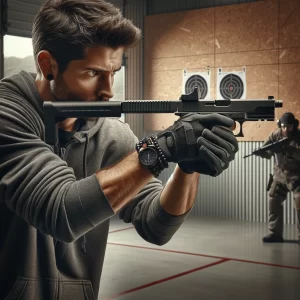
Essential Gun Safety and Secure Storage for Self-Defense
In the realm of self-defense, owning a firearm is a significant responsibility that comes with the need for stringent safety measures. This article delves into the crucial aspects
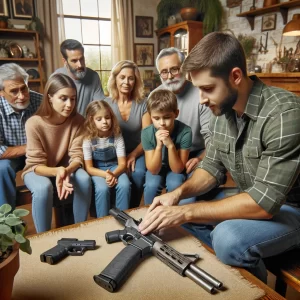
Secure, Educate, Protect: Key to Responsible Gun Ownership
Responsible Gun Ownership: Educating Family and Visitors Responsible gun ownership is not just about the right to bear arms but also encompasses the duty to store, handle, and

Ammunition Storage Safety Tips – Keep Ammo Secure and Safe
Storing ammunition safely is crucial for gun owners. Proper storage not only preserves the ammo but also enhances safety at home. This guide delves into effective methods to
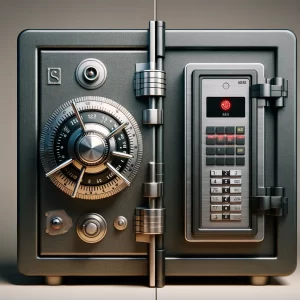
Gun Safe Locks: Mechanical vs. Electronic – Know the Difference
When it comes to gun safe security, the choice between mechanical and electronic locks is crucial. This comprehensive guide explores the pros and cons of each, helping you
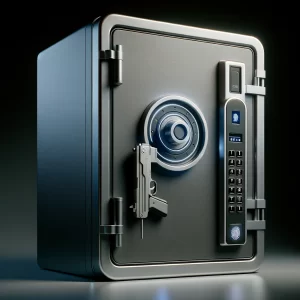
The Top 20 Benefits of Owning a Biometric Gun Safe
As a responsible gun owner, ensuring the safety and security of your firearms is paramount. Biometric gun safes represent a significant advancement in firearm storage, blending cutting-edge technology
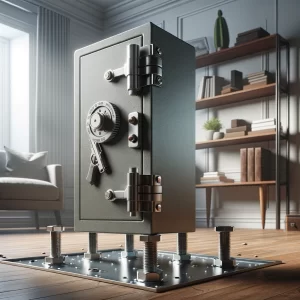
Secure Your Firearms: The Need for Bolt Down Gun Safes
The Importance of Bolt Down Kits for Gun Safe Security When it comes to safeguarding firearms, owning a gun safe is just the beginning. The real security lies

Review: Winchester Big Daddy XLT – Spacious Gun Security
When it comes to safeguarding firearms, choosing the right gun safe is crucial. The Winchester Big Daddy XLT emerges as a standout choice, particularly for those seeking a

Liberty Fatboy Gun Safes Review – Price Meets Quality
When it comes to gun safes, balancing capacity, security, and price is a delicate matter. Among the numerous options available, Liberty Safes’ Fatboy series stands out. In this

Steelwater Standard Duty 16 Review: An Honest Insight
When it comes to securing firearms, a reliable gun safe is non-negotiable. The Steelwater Standard Duty 16 has gained attention in the market, but does it truly offer

2024 Guide to Colorado Gun Laws: Info for Firearms Owners
Colorado’s gun laws have undergone significant changes as of 2024, reflecting the state’s ongoing efforts to balance Second Amendment rights with public safety concerns. This article provides an
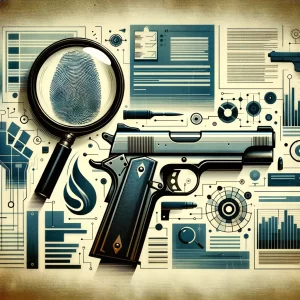
Navigating Firearm Background Checks: Federal & State Guides
When it comes to purchasing a firearm in the United States, understanding the background check process is crucial for compliance and legal adherence. This article demystifies the federal
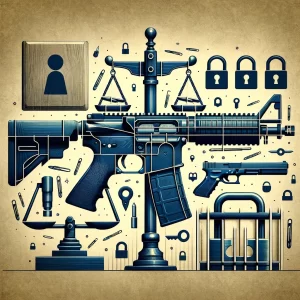
2023-2024 Federal Gun Law Changes: What You Need to Know
Impact of Federal Gun Law Changes for 2023-2024 The landscape of gun laws in the United States is constantly evolving, and the changes made between 2023 and 2024

Oregon Measure 114: Key Changes in Firearm Laws
In the ever-evolving landscape of firearm regulations in the United States, Oregon’s Measure 114 stands as a significant development. This measure, which passed in [insert year], introduces new
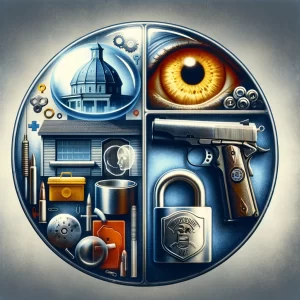
Navigating Michigan’s Firearm Laws: Background Checks & Storage
Owning a firearm in Michigan comes with its own set of responsibilities, especially considering the state’s laws on universal background checks and safe firearm storage. As a gun

NC Handgun Purchase Law: No More Permit Needed
In a significant shift in gun legislation, North Carolina has recently updated its handgun purchase laws, removing the long-standing requirement for a permit. This change represents a notable

Arkansas Gun Laws: Loaded Firearm & Permitless Carry
In the ever-evolving landscape of gun laws in the United States, Arkansas has taken significant steps in redefining its approach to firearm regulation. The state’s updated stance on

Secure Your Gun Safe on Carpet: Easy Anchoring Guide
Owning a gun safe is a big step towards responsible firearm ownership. It keeps your guns secure and away from unauthorized hands. But what about securing the safe
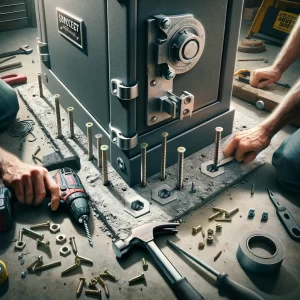
Concrete Floor Anchoring Made Easy: A Step-by-Step Guide
When it comes to setting up a secure environment, whether it’s for storing valuables, firearms, or ensuring the stability of heavy equipment, anchoring to concrete floors is a

Essential Tools & Materials for Gun Safe Installation
Installing a gun safe is an essential task for any firearm owner. Not only does it ensure the safety of your guns, but it also plays a crucial

Male vs. Female Anchors: Your Guide to the Right Choice
When it comes to securing firearms safely and effectively, choosing the right anchoring method is crucial. In the world of gun installations, the debate often boils down to
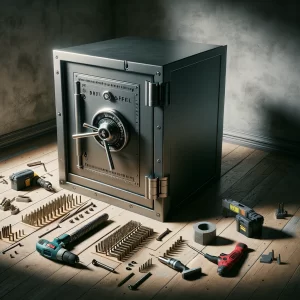
Anchoring Your Gun Safe: Essential Step-by-Step Guide
When it comes to gun safety, securely storing your firearms is paramount. Anchoring your gun safe isn’t just a recommended step; it’s essential for ensuring the safety and

Gun Safety for Kids: Essential Conversations and Tips
In today’s world, where firearms are a common presence in many households, teaching children about gun safety is vital. By opening up conversations and educating our children, we

Firearm Safety: Avoiding Risks When Distressed
The Dangers of Handling Firearms While Distressed Introduction Firearms, designed to be lethal, require the utmost caution and responsibility, especially in emotionally charged situations. Understanding the hazards of
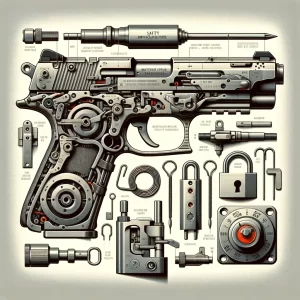
Essential Guide to Gun Safety Mechanisms
Understanding the safety mechanisms of your firearm is crucial for responsible handling and preventing accidents. This comprehensive guide aims to equip you with knowledge about different safety mechanisms

Gun Safe Setup: DIY or Professional? A Comprehensive Guide
When it comes to installing a gun safe, the question often arises: should you do it yourself or hire a professional? Each approach has its merits and challenges.

Expert Guide on Choosing Gun Safe Locks – Find the Perfect Fit
How to Choose the Right Lock for Your Gun Safe When selecting a lock for your gun safe, it’s essential to weigh various factors like security, convenience, and
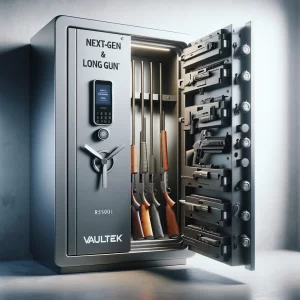
Vaultek RS500i Review: Advanced Security for Long Guns
Vaultek RS500i: Next-Gen Long Gun Security In an era where smart technology integrates seamlessly into every aspect of our lives, it’s no surprise that gun security has followed
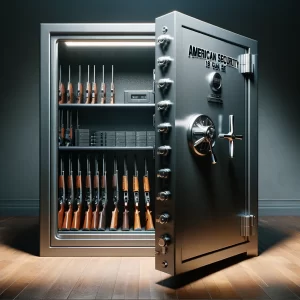
American Security BF6032 Review: Elegant, Secure Gun Safe
When it comes to safeguarding your firearms and valuables, the American Security BF6032 18 Gun Safe stands out with its exceptional blend of security features, fire protection, and
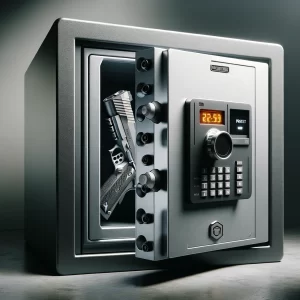
Vaultek MXi Review: Advanced Handgun Safe Security
In the world of handgun safes, the Vaultek MXi stands out as a paragon of security and technology. Vaultek, known for their premium safes and robust growth in
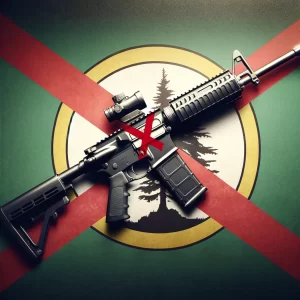
Understanding Washington’s 2023 Assault Weapons Ban for Gun Owners
In April 2023, Washington State enacted a significant piece of legislation, House Bill 1240, fundamentally impacting gun ownership and sales. This law, spearheaded by Attorney General Bob Ferguson

Illinois’ Assault Weapon Ban: Overview and Legal Analysis
In recent years, Illinois implemented a significant legislative change concerning firearms: the Assault Weapons Ban. This controversial measure has spurred debates about second amendment rights, public safety, and
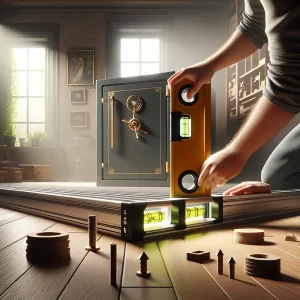
Gun Safe Installation: 15 Leveling & Anchoring Techniques
Installing a gun safe in your home requires careful planning and execution to ensure it’s stable and secure. In this article, we’ll guide you through the basic installation
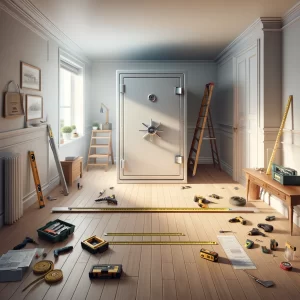
Essential Gun Safe Installation Tips for Every Homeowner
When it comes to securing firearms at home, choosing and installing the right gun safe is a critical step. This comprehensive guide will walk you through the basics

Secure Firearm Storage: Essential Tips for Safety
Firearm safety is a crucial aspect of gun ownership. Safe handling and secure storage of firearms are essential to prevent accidents and unauthorized access, especially in homes with

Essential Firearm Safety Tips for Responsible Gun Owners
Owning a firearm comes with significant responsibility, particularly concerning safety. Whether you’re a seasoned owner or new to firearms, understanding and adhering to safety guidelines is paramount. This
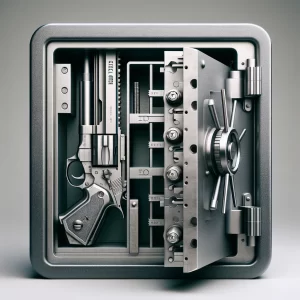
Understanding Steel Gauge in Gun Safes – Essential Guide
The Evolution of Steel in Safe Manufacturing The 19th century marked a significant turning point for the steel industry, particularly with the advent of the modern steel industry.
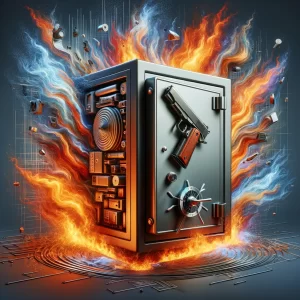
Navigating Gun Safe Fire Ratings: Insights for Secure Selections
Hey there, gun enthusiasts and safety-conscious individuals! Today, we’re diving into the world of gun safes, specifically focusing on fire ratings. Ever wondered what those fire ratings you

ProVault 12-Gun Safe Review: Compact & Budget-Friendly
The ProVault 12-Gun Safe by Liberty is a notable option for gun owners seeking a compact, budget-friendly, yet reliable safe for their firearms and valuables. Made by Liberty

Magnum E-Lock 50-Gun Safe Review: Top Security & Fire Safety
When it comes to safeguarding your firearms and valuables, choosing the right gun safe is crucial. The Magnum E-Lock 50-Gun Safe, a product of the collaboration between Cabela’s
Frequently Asked Questions About Gun Safes and Firearm Safety
Owning a gun safe provides several critical benefits, key among them being safety and security. The most immediate benefit is the prevention of accidental access, particularly by children or other unauthorized individuals. Gun safes ensure that firearms are stored securely, reducing the risk of accidental discharge, which can lead to tragic outcomes.
In addition to safety, gun safes offer protection against theft. Firearms are valuable and can be targeted by burglars. A robust gun safe can deter or completely prevent theft, ensuring that your weapons do not fall into the wrong hands. This aspect is also important for complying with laws in many jurisdictions that mandate secure firearm storage.
Furthermore, gun safes help in preserving the condition of your firearms. Environmental factors like humidity and temperature can affect the performance and lifespan of a gun. Many safes are built to offer a controlled environment, protecting against rust and corrosion.
Insurance is another factor to consider. Some insurance policies offer better terms or lower premiums for firearms stored in a certified safe. This aspect, coupled with peace of mind knowing your firearms are securely stored, underscores the benefits of investing in a quality gun safe.
Choosing the right size for a gun safe depends on several factors including your current firearm collection, potential future acquisitions, and the space available for the safe. Firstly, consider the number and type of firearms you need to store. Handguns require less space than rifles or shotguns. If you have or plan to have a large collection, opt for a larger safe.
Additionally, consider other items you might store in the safe, such as ammunition, accessories, important documents, or valuables. These additional items can quickly consume space, making it advisable to choose a safe slightly larger than your current needs.
The physical space where you intend to place the safe is also crucial. Measure the area carefully, considering not just the floor space but also the door opening and the path to the safe’s final location. Remember, larger safes are not only bigger but also significantly heavier, which might restrict where they can be placed.
Finally, think about future proofing. Your collection may grow, so investing in a slightly larger safe than your current needs might be more cost-effective in the long run. Balancing current needs with future possibilities will guide you in selecting the right size.
When searching for a high-quality gun safe, several features should be considered to ensure optimal security and functionality. The lock mechanism is paramount – look for safes with high-quality locks, such as biometric locks, combination locks, or electronic keypads, which offer a good balance between security and accessibility.
The construction of the safe is also crucial. Opt for safes with thick, solid steel walls and doors that are resistant to tampering and break-ins. The gauge of the steel is important; the lower the number, the thicker the steel. A safe with a rating of at least 10 to 12-gauge steel is a good standard.
Fire resistance is another key feature. Look for safes that offer a certain level of fire protection, usually rated by the amount of time the safe can withstand high temperatures without the interior exceeding a set temperature.
Additionally, consider the interior features such as adjustable shelving, lighting, and a dehumidifier. These features enhance the usability of the safe, keeping your firearms in optimal condition.
Finally, certifications from reputable organizations like Underwriters Laboratories (UL) can provide an added level of assurance in terms of security and quality.
Maintaining your gun safe is essential for ensuring its longevity and functionality. Regularly inspect the locking mechanism and hinges. If your safe has a mechanical lock, it may need to be serviced by a professional every few years. For electronic locks, check the batteries regularly and replace them as needed.
Keep the safe clean both inside and out. Dust and debris can accumulate and potentially interfere with the locking mechanism. Use a soft cloth to wipe down the exterior and interior surfaces. Avoid using harsh chemicals or abrasive cleaners that could damage the finish or interior lining.
Monitor the humidity inside the safe, especially if you live in a humid climate. Excessive moisture can lead to rust and corrosion of your firearms. Consider using a dehumidifier or silica gel packs to maintain a dry environment inside the safe.
Additionally, check the bolts and anchors securing the safe to the floor or wall. Ensure they remain tight and secure, as they can become loose over time. This step is crucial not only for security but also for safety, particularly with larger safes that pose a tipping hazard.
Lastly, periodically review your insurance policy and the contents of your safe. Ensure your policy covers the full value of the contents and keep an inventory of the items stored within, including serial numbers of your firearms, which can be invaluable in case of theft or damage.
While no gun safe is completely fireproof, many are designed to be highly fire-resistant, offering significant protection against fire damage. When evaluating a gun safe’s fire resistance, consider the fire rating, which indicates how long the safe can withstand a certain temperature without the interior exceeding a specific temperature, usually around 350 degrees Fahrenheit, which is the point at which paper starts to char.
The construction of the safe plays a vital role in its fire resistance. Safes with thicker steel and fireboard layers offer better protection. Pay attention to the seals on the door; they should expand in the event of a fire to keep heat and smoke out.
Keep in mind that the location of the safe in your home can also impact its effectiveness in a fire. Safes placed on lower floors, away from areas with high fire risk, generally fare better in the event of a fire.
It’s important to balance fire resistance with other security features. A safe with excellent fire resistance but poor security features may not offer the comprehensive protection you need. Consider your specific circumstances and priorities when selecting a gun safe with fire-resistant properties.
Anchoring your gun safe is a crucial step in enhancing its security and stability. An unanchored safe, especially if it’s not excessively heavy, can be vulnerable to being moved or carried away by burglars. Anchoring it to the floor or wall not only makes it more difficult to steal but also reduces the risk of the safe tipping over, which can be a hazard, especially with taller models.
To anchor your safe, first, choose a suitable location. It should be a place where the safe can be bolted down securely, preferably to concrete or solid wood flooring. If anchoring to a wall, ensure the wall is structurally sound and can support the safe’s weight.
Most safes come with pre-drilled holes in the bottom or back for this purpose. You’ll need appropriate tools and anchors for the specific surface you’re attaching the safe to. Concrete anchors are required for concrete floors, while heavy-duty bolts are needed for wood.
If you’re not confident in doing this yourself, it’s advisable to hire a professional. They can ensure that the safe is securely and correctly anchored, avoiding any potential damage to the safe or your property.
The location of your gun safe in your home is a decision that impacts both security and accessibility. Ideally, it should be in a place that is not immediately visible to guests or intruders but is still easily accessible to you. Avoid obvious locations like the master bedroom or garage, as these are often the first places burglars check.
Consider a location that’s out of sight but within a part of your home that you frequent, ensuring you can access your firearms quickly if needed. Basements can be good choices for their added security and typically cooler, dryer conditions, which are better for firearm preservation.
Ensure the floor can support the weight of the safe, especially for larger models. If you’re placing it on an upper floor, consult a structural engineer to confirm the floor’s load-bearing capacity.
Also, think about environmental factors. Avoid places with high humidity or temperature fluctuations, which can cause rust and corrosion in firearms. Using a dehumidifier in the room or in the safe can mitigate these risks.
Lastly, consider fire safety. Placing the safe away from potential fire sources and in a location where it can be reached by firefighters can help protect its contents in case of a fire.
Smart technology is increasingly being integrated into gun safes, offering features like remote access, monitoring alerts, and biometric locks. These technologies can enhance both convenience and security. For instance, biometric locks allow for quick and personalized access, while remote monitoring can alert you to any unauthorized attempts to access the safe.
However, with any internet-connected device, there are cybersecurity concerns. It’s crucial to ensure that any smart gun safe you consider has robust security protocols. Look for safes that use encryption for data transmission and offer regular software updates to protect against hacking.
When using smart safes, it’s advisable to maintain traditional security measures as backups, such as mechanical locks or keypads. This ensures that you still have access to your safe in case of technology malfunctions or power outages.
Legal requirements for gun safes vary widely depending on your location. In some places, there are specific mandates on how firearms must be stored, often requiring them to be secured in a locked container or safe. These laws are typically designed to prevent access by unauthorized persons, particularly children, and to reduce theft.
It’s important to familiarize yourself with the local and state laws where you reside. Some jurisdictions may have specific requirements about the type of lock, the safe’s construction, or even where in the home the safe can be placed. Failing to comply with these laws can result in legal consequences.
In addition to governmental regulations, consider any requirements or recommendations provided by your home insurance provider. Some insurance policies offer reduced rates if firearms are stored in a certified safe, or they might require specific storage methods to cover theft or damage of firearms.
Ensuring the longevity of your gun safe involves regular maintenance and proper usage. Keep the safe clean, dusting it regularly, and inspecting for signs of wear or damage. Pay special attention to the lock and hinges, lubricating them as necessary to keep them functioning smoothly.
Protect your safe from environmental extremes. If it’s located in a place with high humidity, use a dehumidifier. Similarly, avoid placing it where it can be exposed to direct sunlight or extreme temperatures.
Be mindful of how you use the safe. Overloading it or frequently using excessive force to close the door can lead to wear and tear. Organize the contents neatly to avoid straining the shelves and door.
Finally, consider a professional inspection every few years, especially for safes with complex locking mechanisms or electronic components. A professional can identify issues that might not be obvious and ensure your safe remains in top condition.
Losing access to your gun safe due to a forgotten combination or a lost key can be a stressful situation. First, check if there are any override keys or secondary access methods provided with the safe. Many safes come with backup keys or have an alternative unlocking method for such scenarios.
If these options are not available or you have lost the backup key, consult the safe’s manual or manufacturer’s website for guidance. Some safes have a reset procedure, although this often requires at least partial access to the safe’s interior or proof of ownership.
If these steps are not viable, contact a professional locksmith who specializes in safes. These experts can often open the safe without damaging it. Be prepared to provide proof of ownership and identification.
To prevent future occurrences, consider keeping a record of your combination or key in a secure, separate location, and regularly maintain and test any electronic components or batteries if your safe uses an electronic lock system.
Storing ammunition in gun safes requires careful consideration for safety and longevity. While it’s convenient to store ammo in the same safe as your firearms, ensure the safe is adequately sized to avoid overcrowding. Ammunition should be stored in a cool, dry environment to prevent deterioration. Excessive humidity can lead to corrosion or misfires.
Use original packaging or durable containers to organize ammunition and protect it from moisture. Some gun safes come with separate compartments or shelves designed for ammunition storage, which can be very useful.
Always adhere to local laws and regulations regarding ammunition storage. Some jurisdictions have specific requirements separate from those for firearm storage.
Be aware that storing large quantities of ammunition may require a safe with enhanced fire protection. In a fire, ammunition can pose additional hazards.
Gun safes typically come with either mechanical (dial) or electronic locks, each with their own advantages and considerations.
Mechanical locks are known for their durability and reliability. They don’t rely on batteries or electronic components, which means less maintenance and no worries about electronic failures. However, they can be slower to open and require more skill to operate accurately.
Electronic locks offer convenience and speed, allowing for quicker access with a personal code. Many also feature multiple user codes and easy combination changes. The downside is their reliance on batteries and electronic components, which can fail or require regular replacement and maintenance.
Your choice depends on your personal preferences, lifestyle, and how you prioritize convenience versus traditional reliability.
While gun safes are primarily designed to secure firearms against theft and unauthorized access, some are also built to withstand extreme conditions like floods or earthquakes. When selecting a safe, consider its construction and sealing capabilities. For flood protection, look for safes with waterproof seals that can protect the contents for a certain period submerged underwater.
For earthquake resistance, the safe should be of solid construction and properly anchored to the ground or wall to prevent tipping or shifting. Remember, no safe is entirely impervious to natural disasters, but certain designs and installation methods can significantly enhance protection in such events.
Disposing of an old gun safe should be done responsibly. Due to their size and construction materials, gun safes are not typically suitable for regular waste disposal. Contact your local waste management services to inquire about large item pickup or recycling options.
Alternatively, consider donating your safe to a local shooting range, police department, or firearm safety organization, provided the safe is still in working condition.
For recycling, you’ll need to find a facility that can handle large metal objects. The safe may need to be broken down into smaller pieces, which could require professional assistance.
Always ensure that the safe is completely empty and unlocked before disposal or recycling. This prevents potential hazards and makes the process easier for those handling the safe.
Organizing firearms in a gun safe efficiently and safely is essential. The primary goal is to prevent damage to the firearms while also ensuring they are easily accessible in case they are needed. Start by using the built-in racks or shelves most gun safes come with. These are designed to hold firearms in a way that minimizes contact and potential scratching.
Rifles and shotguns should be stored vertically with barrel up, using the safe’s rack system. This prevents them from knocking against each other and maintains their balance. For handguns, use shelving or door-mounted holsters, which are great space savers and keep handguns readily accessible.
Always keep firearms unloaded while in the safe, particularly if they’re stored for longer periods. This is a critical safety measure to prevent accidental discharge. Also, use trigger locks or other locking devices as an added safety layer, especially if children are in the house.
Store ammunition separately from the firearms, ideally in a different compartment or shelf within the safe. This is not just a safety measure but also helps in organizing and preserving the ammunition.
Regularly check and maintain your firearms even when they are in storage. Ensure they are clean and dry before placing them back in the safe. This routine prevents rust and ensures the firearms are in good working condition.
Child-proofing a gun safe is crucial to ensure the safety of children in any environment where firearms are present. The most effective way to child-proof a gun safe is to choose a model with a complex locking mechanism that a child cannot easily operate. Biometric locks, sophisticated electronic keypads, or combination dials are generally more secure against child tampering than basic key locks.
Beyond the lock itself, the safe should be placed in a location that is not easily accessible or attractive to children. Avoid placing it in common areas or places where children often play. If possible, keep the safe’s location discreet to prevent curiosity.
Educate children about the dangers associated with firearms from an early age. While this doesn’t replace the need for a secure gun safe, it adds an additional layer of safety by fostering awareness and respect for firearms.
Regularly test the lock and access mechanisms of the safe to ensure they are functioning correctly. Over time, locks can wear out or become less responsive, which might make them easier to open.
Finally, consider installing an alarm system on your safe or a home security system that alerts you when the safe is accessed. This can provide immediate notification if a child or anyone else tries to access the safe.
Improper firearm storage can lead to serious and sometimes tragic consequences. The most immediate risk is unauthorized access, particularly by children or individuals unfamiliar with firearm safety. This can result in accidental discharges, leading to injury or death.
In many jurisdictions, improper storage of firearms can result in legal repercussions. These can include fines, criminal charges, and in some cases, imprisonment, especially if negligence leads to an accident. Many areas have specific laws dictating how firearms must be stored, often requiring them to be secured in a locked container or safe.
There’s also a heightened risk of theft if firearms are not securely stored. Stolen firearms are a significant concern as they often end up being used in criminal activities. This not only poses a broader public safety issue but can also lead to legal troubles for the original owner if the stolen firearm is traced back to them.
Beyond safety and legal concerns, improper storage can lead to damage to the firearms themselves. Without proper storage, guns are susceptible to rust, dust, and other environmental factors that can degrade their quality and functionality.
Proper firearm storage is therefore not only a matter of personal responsibility but also a community and legal obligation. Investing in a secure storage solution like a gun safe and adhering to safe storage practices is essential for any firearm owner.
Yes, gun safes can often be customized to cater to specific needs or preferences. Many manufacturers offer a range of customization options. For interior customization, you can choose from different types of shelving, racks, and drawers. These can be configured to accommodate various types and sizes of firearms, as well as ammunition and accessories.
For exterior customization, options may include different finishes, colors, and hardware, allowing the safe to blend with your home decor or stand out as per your preference. Some safes also offer custom door panel organizers for additional storage and ease of access.
Security features can often be customized as well. You can choose from different types of lock mechanisms, such as biometric, electronic, or dial locks, based on your comfort and security needs. Advanced features like multi-lock systems or tamper alarms can also be added for enhanced security.
